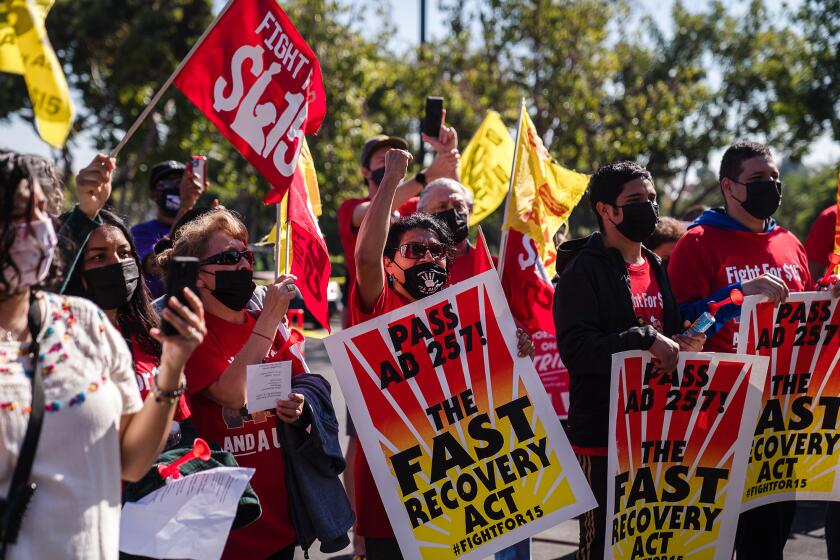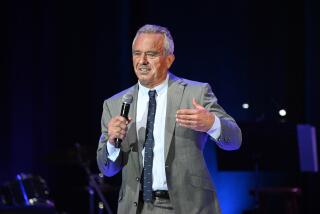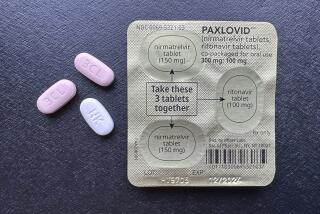Column: These pundits and pols say they’re ‘done with COVID.’ But COVID’s not done with us

- Share via
At a certain level, it’s understandable that nearly two years of pandemic-related restrictions have people fed up and desperate to get back to some semblance of normal life.
But that’s no excuse for the premature and dangerous declarations by elite commentators and vote-scrounging politicians that the crisis is over. For them and their social circles and fellow ideologues, perhaps it is over. Many live in a bubble that has protected them from the worst ravages of COVID-19.
For millions of Americans, however, it’s not nearly over.
They’re the survivors left behind by the 67,000 Americans who died of COVID in the last month, as reported by the Centers for Disease Control and Prevention, not to forget the survivors, relatives and friends of the nearly 900,000 Americans who have perished in the pandemic, and the countless more suffering “long COVID” — those whose health has been compromised for months or possibly years by their encounter with the virus.
It’s jarring to hear elite commentators saying, ‘It’s over, put the masks away,’ at the same time that you have people dying, being out of work because they’re sick or their kids are sick, wondering how they’re going to pay the rent.
— Economist Claudia Sahm
To place only the most recent 67,000 deaths in perspective, that’s more than all the American deaths suffered in the Vietnam War, which lasted (depending on how one counts) 10 years. One Vietnam War, compressed into 30 days.
The daily average of new deaths this month alone, 3,164, is more than the total number of deaths recorded in the 9/11 attacks. That’s more than one 9/11 per day in the month of February.
Get the latest from Michael Hiltzik
Commentary on economics and more from a Pulitzer Prize winner.
You may occasionally receive promotional content from the Los Angeles Times.
Another pertinent point: The deaths and suffering from the pandemic are still — as they have been from the start — concentrated among society’s most vulnerable members — the lowest-income workers and those with the fewest educational degrees.
They’re the people without the resources or the indulgent employers allowing them to work from home, preserving their income through the crisis.
The greatest pressures and risks are still being borne by our front-line healthcare workers, who are being burned out by the scarcely ebbing pace of treating COVID patients.
Florida Gov. Ron DeSantis thinks boasting about his anti-lockdown stance and attacking Anthony Fauci are a winning political play for him, even as COVID rages out of control in his state.
“It’s jarring to hear elite commentators saying, ‘It’s over, put the masks away,’ at the same time that you have people dying, being out of work because they’re sick or their kids are sick, wondering how they’re going to pay the rent,” says Claudia Sahm, a former Federal Reserve economist and director of macroeconomic research at the nonprofit Jain Family Institute, who has been mining government statistics to determine the demographics of pandemic victims.
“Emergency room doctors, everyone who’s checking out our groceries, serving our food, they ought to be offended,” Sahm told me.
They’re not “done with COVID.”
This smug, unfeeling phrase comes from Bari Weiss, a right-wing pundit who railed against COVID restrictions on Jan. 21 on the HBO talk show “Real Time With Bill Maher.”
“I’m done with COVID, I’m done,” Weiss proclaimed. “I went so hard on COVID — I sprayed the Pringles cans that I bought at the grocery store, stripped my clothes off because I thought COVID would be on my clothes, I did it all. And then we were told, you get the vaccine, and you get back to normal ... and we haven’t got back to normal.... It’s not real anymore.”
Weiss’ viewpoint is shared by not a few governors and other political leaders who have been rushing to lift pandemic-era restrictions such as mask and vaccine mandates. They’ve been backed by judges, including a majority on the Supreme Court, who take the view that COVID is not a sufficiently serious threat to justify mandates and restrictions aimed at protecting public health.
I think we can all sympathize with what Weiss went through, what with the spraying down of Pringles cans and so on and so forth. But let’s not overlook that she and Maher took the opportunity to feed their viewers some truly dangerous misinformation about the pandemic.
Weiss, for instance, dragged out a widely questioned statistic suggesting that suicides among teenage girls spiked during pandemic-related school closures.
Suicide experts caution against taking that claim at face value: There are figures indicating that suicides have actually fallen during school closures — that’s consonant with expert findings that teen suicides tend to decline when school is out, as during summer vacations.
The Fast Recovery Act heading for a vote in the California Senate would remake the franchise industry for the better.
Maher cited statistics suggesting that the states that had instituted strong mitigation measures hadn’t done appreciably better than those that remained wide open. “Massachusetts and West Virginia ... right together,” he said. “Could there be two states that are more unalike?”
As emergency medicine expert Jeremy Faust points out, however, Maher’s figures represent a triumph of data cherry-picking. It’s true that many pro-mitigation states have similar overall death rates as those of wide-open states.
But that’s at least partially an artifact of the toll from the earliest months of the pandemic, before we had better understanding of how to treat severe disease, how to reduce transmission via masks and social distancing and before vaccines. It wasn’t until the appearance of the Delta variant in the summer of 2021 that the differences in approach began to bear fruit.
Let’s look at those figures again. Massachusetts and West Virginia have suffered similar death rates since the pandemic started in March 2020 — 325 and 326 deaths per 100,000 population, respectively. In the Delta and post-Delta period, however (counting from July 1, 2021), the death rate per 100,000 in Massachusetts has been 64.5; in West Virginia, 164.2.
Looking at two other states Maher cited, wide-open Florida and strict New Jersey, the full-pandemic death rates would seem to point to the virtues of staying open — Florida’s rate is 307 per 100,000, New Jersey’s 359.
New Jersey’s figures are skewed, however, because the state was hit heavily in the first few months of the pandemic. From the onset of Delta, Florida’s death rate has been 129.3 per 100,000, New Jersey’s 61.5.
We’ll throw in another common comparison here beloved of fans of Florida Gov. Ron DeSantis — Florida vs. California. Overall, California’s strict approach shows its benefits — its death rate of 203 vs. Florida’s 307 signifies that 41,000 more Californians would have died from COVID than the 81,000 who perished if the state had Florida’s record.
But in the Delta era, California really shows its wisdom. Its death rate of 64.5 since July 1 is almost half of Florida’s.
How should we think about anti-vaccine activists who die from COVID?
Maher asserted that the figures on total COVID deaths in the U.S., now approaching 900,000, are “squishy.” This is a wholly ignorant and irresponsible stab at making the pandemic look less devastating than it is. Maher owes the entire country an apology.
The figures demonstrate that state-level death rates began to diverge after the passing of the first COVID wave at the end of June 2020, Faust calculated.
If the entire country had the excess death rates since July 1, 2020, of the 10 states with the lowest rates — Washington, Minnesota, New Jersey, Maine, New York, Hawaii, Connecticut, New Hampshire, Massachusetts and Vermont — he writes, “the U.S. would have recorded approximately 425,000 fewer excess deaths ... than it actually has.”
In other words, its total COVID deaths would have been cut in half.
It’s not irresponsible to start thinking now about what would warrant putting a green light on the exit ramp for any or all pandemic restrictions. Authorities may keep an eye on indicators such as hospitalization rates and intensive care unit capacity as well as new case rates and positive test results.
California is starting to liberalize its rules, like some other states: Starting next week, California will lift its statewide universal mask mandate for indoor public places. Localities, including Los Angeles County and much of the Bay Area, will keep their mandates in place for now. Statewide, masks still will be required indoors for unvaccinated residents and for everyone in locations such as nursing homes or while aboard public transit.
But by those measures and others, declaring the crisis to be “over” looks way premature.
That brings us back to examining who has suffered the most from the pandemic. “Among working-aged Americans, those with 2019 household incomes less than $25,000 were 3.5 times as likely to report missing an entire week of work mainly due to their own or loved ones’ COVID-19 symptoms, relative to those earning $100,000 or more,” reports Julia Raifman of Boston University.
Access to and uptake of vaccines and boosters are closely correlated with income.
The share of fully boosted Americans with incomes less than $25,000 is only 22.2%, compared with 43% among those with incomes in the $75,000-to-$100,000 range and 56.6% of those with incomes of $100,000 or more.
Among adults with fewer than two vaccine doses, 6% of those earning less than $25,000 reported not working at all in the week that ended Jan. 10, according to the Household Pulse Survey of the Census Bureau. Among those earning more than $100,000, the figure was only 2.2%.
Contrary to Weiss’s televised balderdash, we know that masks work to stem transmission — even cloth masks are better than no masks. Medical experts and public health experts haven’t claimed that the vaccines would be 100% effective (no vaccine has ever reached that level of efficacy), but it’s absolutely true that they have helped place the country on the path to normalcy.
According to Bureau of Labor Statistics surveys covering February through May last year, working from home is a privilege closely correlating with educational attainment: More than two-thirds of those with a bachelor’s degree or higher could work from home part or all the time; for those without even a high school diploma, the figure was less than 18%.
Let’s not forget that only about 1 in 4 Americans still get paid when they’re out of work because they or a family member has come down with COVID; that’s an indication of how few American workers have access to sick pay or sick leave.
“For most workers,” Sahm told me, “if they miss one week’s worth of pay, that’s a really bad month.”
That underscores the sheer selfishness and narcissism of the Bari Weisses of the world who’ve decided that the minor inconveniences imposed by COVID rules are simply too much to bear. These are people who can wield their tools of the trade, namely keyboards and laptops, from anywhere, as opposed to those who have to place themselves on the front line to earn their hourly pay.
For them to promote policies that will increase health hazards for others, not themselves, is beneath contempt.
“There are people who are in harm’s way who are buying into the back-to-normal messaging,” Sahm says. “They’re taking off their masks, not getting their vaccines. Those are the ones who are going to die or get long COVID. They are going to pay dearly.”
It may well be true that the back-to-normal advocates won’t be wrong in the longer term, but are just talking prematurely now. Sooner or later we will have ways to deal with COVID as if it’s another endemic disease, like the flu. But we’re not there yet. If you doubt it, ask your nearest ER doctor.
More to Read
Get the latest from Michael Hiltzik
Commentary on economics and more from a Pulitzer Prize winner.
You may occasionally receive promotional content from the Los Angeles Times.














